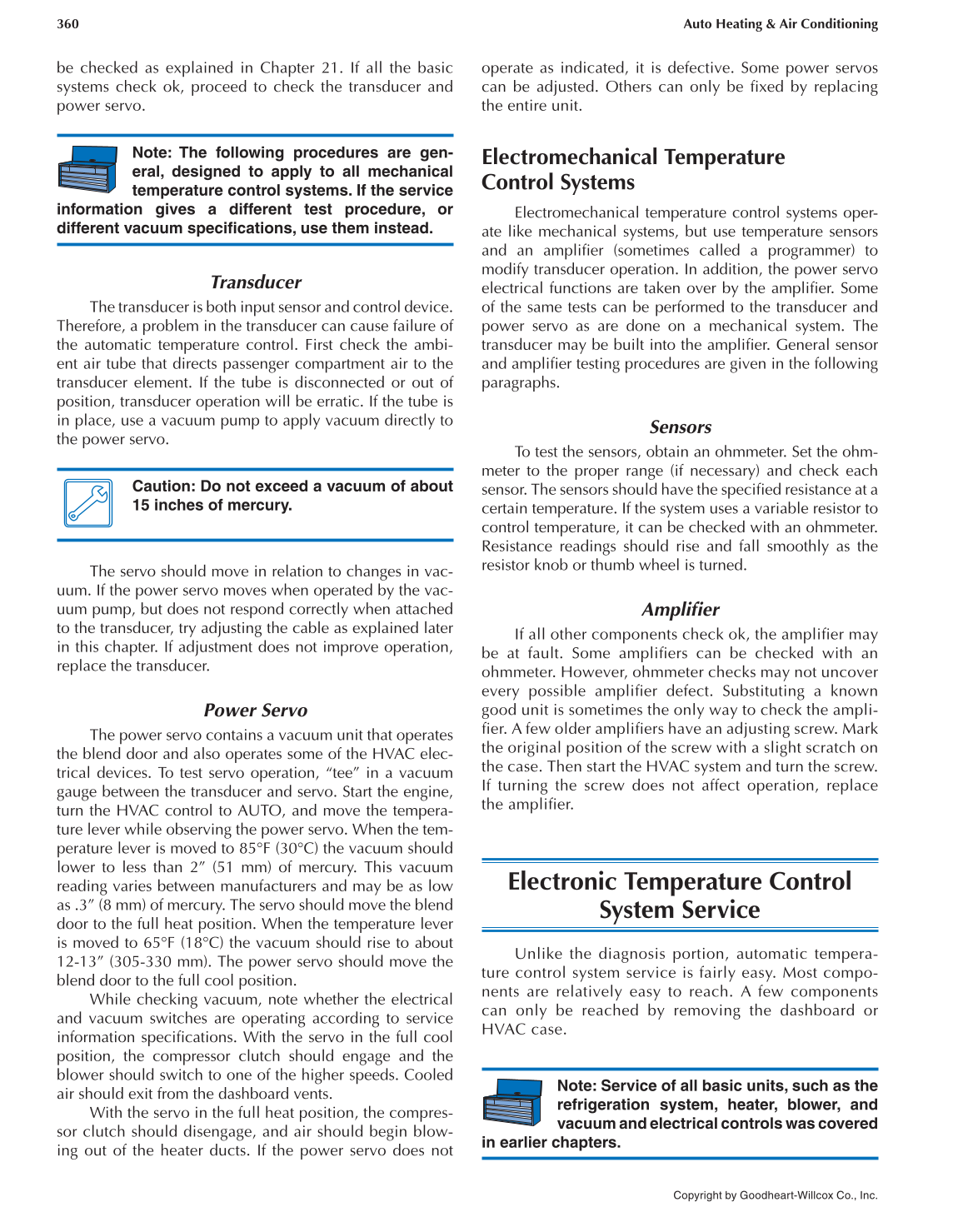360 Auto Heating & Air Conditioning
Copyright by Goodheart-Willcox Co., Inc.
be checked as explained in Chapter 21. If all the basic
systems check ok, proceed to check the transducer and
power servo.
Note: The following procedures are gen-
eral, designed to apply to all mechanical
temperature control systems. If the service
information gives a different test procedure, or
different vacuum specifi cations, use them instead.
Transducer
The transducer is both input sensor and control device.
Therefore, a problem in the transducer can cause failure of
the automatic temperature control. First check the ambi-
ent air tube that directs passenger compartment air to the
transducer element. If the tube is disconnected or out of
position, transducer operation will be erratic. If the tube is
in place, use a vacuum pump to apply vacuum directly to
the power servo.
Caution: Do not exceed a vacuum of about
15 inches of mercury.
The servo should move in relation to changes in vac-
uum. If the power servo moves when operated by the vac-
uum pump, but does not respond correctly when attached
to the transducer, try adjusting the cable as explained later
in this chapter. If adjustment does not improve operation,
replace the transducer.
Power Servo
The power servo contains a vacuum unit that operates
the blend door and also operates some of the HVAC elec-
trical devices. To test servo operation, “tee” in a vacuum
gauge between the transducer and servo. Start the engine,
turn the HVAC control to AUTO, and move the tempera-
ture lever while observing the power servo. When the tem-
perature lever is moved to 85°F (30°C) the vacuum should
lower to less than 2” (51 mm) of mercury. This vacuum
reading varies between manufacturers and may be as low
as .3” (8 mm) of mercury. The servo should move the blend
door to the full heat position. When the temperature lever
is moved to 65°F (18°C) the vacuum should rise to about
12-13” (305-330 mm). The power servo should move the
blend door to the full cool position.
While checking vacuum, note whether the electrical
and vacuum switches are operating according to service
information specifi cations. With the servo in the full cool
position, the compressor clutch should engage and the
blower should switch to one of the higher speeds. Cooled
air should exit from the dashboard vents.
With the servo in the full heat position, the compres-
sor clutch should disengage, and air should begin blow-
ing out of the heater ducts. If the power servo does not
operate as indicated, it is defective. Some power servos
can be adjusted. Others can only be fi xed by replacing
the entire unit.
Electromechanical Temperature
Control Systems
Electromechanical temperature control systems oper-
ate like mechanical systems, but use temperature sensors
and an amplifi er (sometimes called a programmer) to
modify transducer operation. In addition, the power servo
electrical functions are taken over by the amplifi er. Some
of the same tests can be performed to the transducer and
power servo as are done on a mechanical system. The
transducer may be built into the amplifi er. General sensor
and amplifi er testing procedures are given in the following
paragraphs.
Sensors
To test the sensors, obtain an ohmmeter. Set the ohm-
meter to the proper range (if necessary) and check each
sensor. The sensors should have the specifi ed resistance at a
certain temperature. If the system uses a variable resistor to
control temperature, it can be checked with an ohmmeter.
Resistance readings should rise and fall smoothly as the
resistor knob or thumb wheel is turned.
Amplifi er
If all other components check ok, the amplifi er may
be at fault. Some amplifi ers can be checked with an
ohmmeter. However, ohmmeter checks may not uncover
every possible amplifi er defect. Substituting a known
good unit is sometimes the only way to check the ampli-
fi er. A few older amplifi ers have an adjusting screw. Mark
the original position of the screw with a slight scratch on
the case. Then start the HVAC system and turn the screw.
If turning the screw does not affect operation, replace
the amplifi er.
Electronic Temperature Control
System Service
Unlike the diagnosis portion, automatic tempera-
ture control system service is fairly easy. Most compo-
nents are relatively easy to reach. A few components
can only be reached by removing the dashboard or
HVAC case.
Note: Service of all basic units, such as the
refrigeration system, heater, blower, and
vacuum and electrical controls was covered
in earlier chapters.
